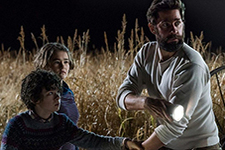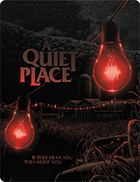A Quiet Place (4K UHD)
|  In the concluding paragraph of his essay “Horror Sound Design” in the anthology A Companion to the Horror Film, film scholar William Whittington notes that “silence in film has never been silent. It is filled with both noise and meaning—most readily it symbolizes death.” Even though (or perhaps because) contemporary cinema soundtracks are awash in multi-layered sound effects made possible by all manner of digital technologies, silence carries with it a particularly powerful charge, which Whittington notes, within the horror genre, “is still cause for ‘alarm.’ When the wind stops or the footfalls cease, death is near.” Part of the unsettling effectiveness of John Krasinski’s gripping horror-thriller A Quiet Place is that it fundamentally inverts the typical relationship in the horror genre between silence and death. In Krasinski’s film, silence is absolutely essential to life, and sound of virtually any kind is a guarantee of not just death, but a horrifying, grisly, demeaning death at the claws and teeth of monstrosities that have taken over the world, but manage to remain almost completely out of sight. Virtually no information is given about these creatures—what they are, where they came from, what they want other than to eat every human being and animal on the planet, or even how many of them there are—which makes them all the more malevolent and frightening. In fact, if the film has a weakness, it is that it eventually gives in and puts the monsters on full display in the film’s climax, which saps them of some of their nightmarish power by making them too specific. While Krasinski, as Spielberg did so masterfully with the shark in Jaws (1975), manages to keep the monstrosities largely off screen and in the darkest corners of our minds for the film’s first half, he can’t help but gradually bring them out of the darkness and in front of the camera lens. The story follows a single, isolated family—husband and wife Lee and Evelyn (John Krasinski and Emily Blunt) and their three children—Regan (Millicent Simmonds), a young teenager who is deaf; middle child Marcus (Noah Jupe); and preschooler Beau (Cade Woodward)—as they attempt to survive in a grim, post-apocalyptic world that is largely devoid of other people and in which they must conduct all their activities in complete and utter silence. The film’s monsters, you see, are completely blind, but they have incredible hearing, and if they hear you make even the slightest sound, they come crashing out of the woods or wherever they are lurking and take you with swift, terrifying force, a lesson we learn with distinct clarity in the film’s instructive opening sequence. Thus, there is virtually no dialogue in the film, as the characters, who live on a remote farm and rarely venture outside its borders, cannot even speak in a whisper without risking an attack, which interestingly implicates us the viewers, as we find ourselves holding our breaths and avoiding making any noise as if a rattle of popcorn in the theater will bring untimely death onto the characters. The family communicates almost entirely in sign language and in gestures, and they have developed all manner of techniques to keep their actions as quiet as possible, including always walking barefoot, leaving thick trails of soft material like sand on their typical paths, building a (mostly) soundproof room in the cellar, and always leaving doors open (the constantly left-open doors are one of the most compellingly ironic subversions of typical horror tropes). There are some points where they able to speak in a normal voice because they can mask their words with something occurring in nature, such as a rumbling waterfall, but otherwise nothing can be spoken aloud. Sound, rather than silence, portends death. There are several complicating factors with which the family must deal, including Regan’s lingering guilt over an earlier incident that she feels has caused her to lose the love of her father and Evelyn’s pregnancy, which, while evidence of the potential for the human race to continue, also leaves us with the lingering question of how they can possibly survive with a crying infant (my mind was constantly going back to the most gut-wrenching scene in Agnieszka Holland’s In Darkness [2011], in which a group of Polish Jews hiding from the Nazis in the sewer system of Lvov must do the unthinkable when a recently born baby begins to cry and possibly alert the Germans to their presence). Thus, an event that should be happy and joyous carries with it the possibility of violent demise for the whole family, which is part of what sets the entire film on edge. You don’t realize how much sound you make just living until your very survival depends on being completely soundless in everything you do, and the manner in which the family goes about ensuring their lives of silence is often ingenious. The screenplay, which was originally penned by relative newcomers Bryan Woods and Scott Beck before being reworked by Krasinski to amplify the underlying themes about parenthood and the deep parental fear of losing a child, is a model of narrative efficiency, as it gives us all the information we need and nothing more (the rather obvious use of a constantly present white board in the background of the cellar is a bit too obvious at times). The film develops a realistic and moving family dynamic, with each character laboring under his or her own burden; Lee and Evelyn, for example, feel the immense weight of needing to protect their children in a world reeling in death, while Regan struggles against the dragging force of her own guilt, which isolates her emotionally. Krasinski, who until now has directed two dark comedies, Brief Interviews With Hideous Men (2009) and The Hollars (2016), displays a striking sense of how horror films work (despite claiming in interviews that, as a self-described “fraidy cat,” he has previously had no interest in the genre), and he manages to evoke and sustain an immense sense of dread that keeps us in a rarefied state of heightened attention; it is the kind of film that makes you afraid to let your guard down. The lack of sound makes the images even more powerfully present, and we are at all times in anxious anticipation of that accidental noise that will bring out the monsters—a compelling emotional experience that, combined with the film’s surprisingly deep sense of character, makes A Quiet Place is a uniquely laudable thriller.
Copyright © 2020 James Kendrick Thoughts? E-mail James Kendrick All images copyright © Paramount Pictures Home Entertainment | |||||||||||||||||||||||||||||
Overall Rating: 


 (3.5)
(3.5)


